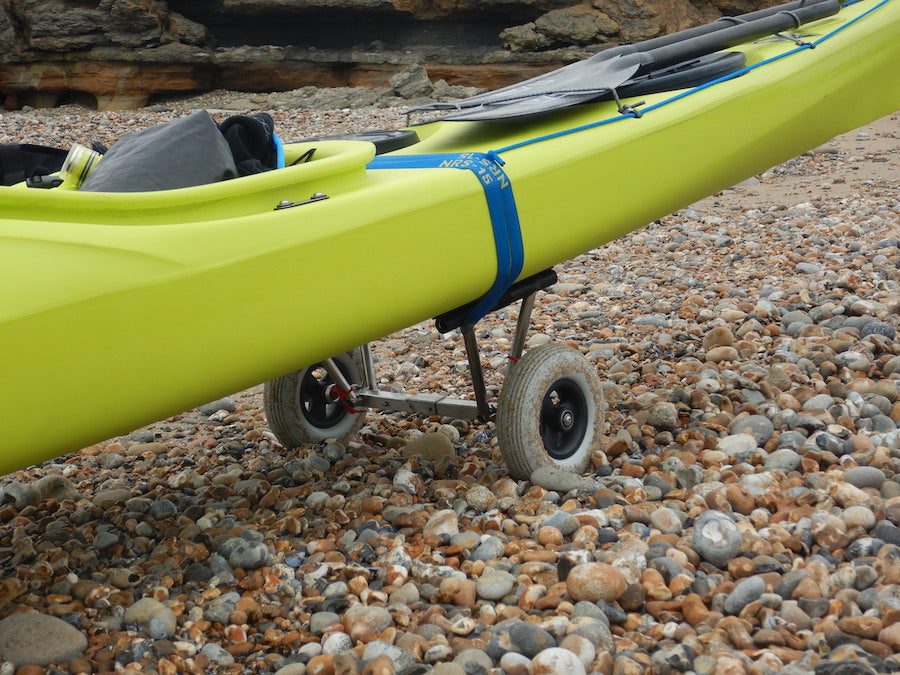Start a conversation with someone about canoe carts and soon it will be about the wheels. Small, large, wide, narrow, pneumatic tires, bearings… far too many choices and options you would say! The trick is to bring it back to what a wheel is supposed to do! To get a little insight into the properties of wheels, I want to tell you about the advantages and disadvantages of the most common types.
It is obvious of course that how you will use your cart also largely determines what requirements you place on your wheels. A short walk from the parking lot to the water is considerably less demanding than sailing around Iceland with a fully loaded sea kayak. In addition, everyone has different desires. One finds smooth-running wheels important, the other is disappointed when his wheels sink into the sand and ponders 'I wish I had brought those balloon tires with me'. 'Not for me', the sea kayaker replies, 'they wil never fit into in my hatch, I'll pull a little bit harder.' But the same applies to everyone: you want to get from A to B and preferably as easily as possible.
 |
 |
 |
 |
 |
 |
Hard or soft surface
Driving on a hard surface works with all wheels, the difference is in the rolling resistance, with a small wheel it is of course higher and you have to pull harder on your kayak than when you put large wheels under your cart.
With or without bearings
What can also make the difference here is whether or not there are bearings. Put bearings in a small wheel and a large wheel without bearings is left behind. It is important that stainless steel bearings with good seals are used.
Wheels without bearings excel in simplicity, simply slide on the frame, secure it and you're done! Very nice except if you drive a lot on sand and after a while the axle is worn out and your wheel lies alongside your trolley.
Wide or narrow
Where it often frays is when you want to ride on the beach. This is where big and wide wheels are at an advantage, but try to put those in your hatch! Tying to the back of your kayak is not such a problem for inland water, but at sea it can be a safety hazard.
Pneumatic tire or foam-filled
One kayaker swears by pneumatic tires that absorbs bumps better and run lighter, the other doesn't feel like fiddling with pumps and the risk of an flat tire when you need it. Wheels with foam filling are an alternative, run just as smoothly, but slightly less on a softer surface. And of course you will never have flat or soft tires again
Conclusion
All this means that the ideal wheel does not exist, excelling in one situation means compromising in another. It's about comparing your wishes and the pluses and minuses, making a choice and then hoping that it fits your cart.
EasyMarcs® wheels
I made the following choices with my Easymarcs® kayak trolley:
- Easy Riding
- Reliable
- High load capacity
- Fits in small hatch
- No pneumatic tire because of the possibility of a flat and fiddling with pumps.
The result is a foam-filled wheel of 19.5 cm that just fits in a small hatch, fitted with stainless steel ball bearings for smooth running and that cannot go flat, can handle 60 kg each and is therefore reliable.
And what about riding on the beach? Be patient, the solution is coming! With the same wheels provided.
| Pros | Negatives | |
| Small wheel <20cm | Compact, more stable with sufficiently wide frame. | Sinks faster in soft soil. Ground clearance limited. |
| Large wheel >20cm | Smooth running and rolls better over obstacles, the bigger the better in loose sand. | Only fit in large shutters. Higher cart is less stable. |
| Narrow wheel <5cm | Compact, weight | Sinks deep into loose sand. Often stiffer rubber with jumpy behaviour. |
| Wide wheel >5cm | Suitable for all surfaces | Voluminous, does not fit in every hatch. Sometimes tied to the back of a kayak which can be risky. |
| Balloon wheel | Ideal for sand. | Large packing volume, large hatch required. Limited use. |
| Pneumatic tyre | light ride, forms to the surface by adjusting air pressure. | Can leak, take pump with you. chance of being empty when you don't want it. |
| Foam filled wheel | Smooth running, cannot leak. Solid. | Slightly less elastic than pneumatic tyre. No possibility to play with air pressure. |
| Hard plastic wheel | Solid, not puncturable, often wider and then good in the sand. | Makes more noise on hard surfaces, more sensitive to wear. |
| Bearings fitted | Smooth running, significantly less pulling force required, no frame wear, durable with the right bearings. | More expensive, more complex construction. Vulnerable if incorrect bearings are used or improper sealing. |
| No bearings | Cheaper, simple construction. | Drives considerably heavier than with bearings. Wheel and frame wear from sand and water. Shorter lifespan. |

